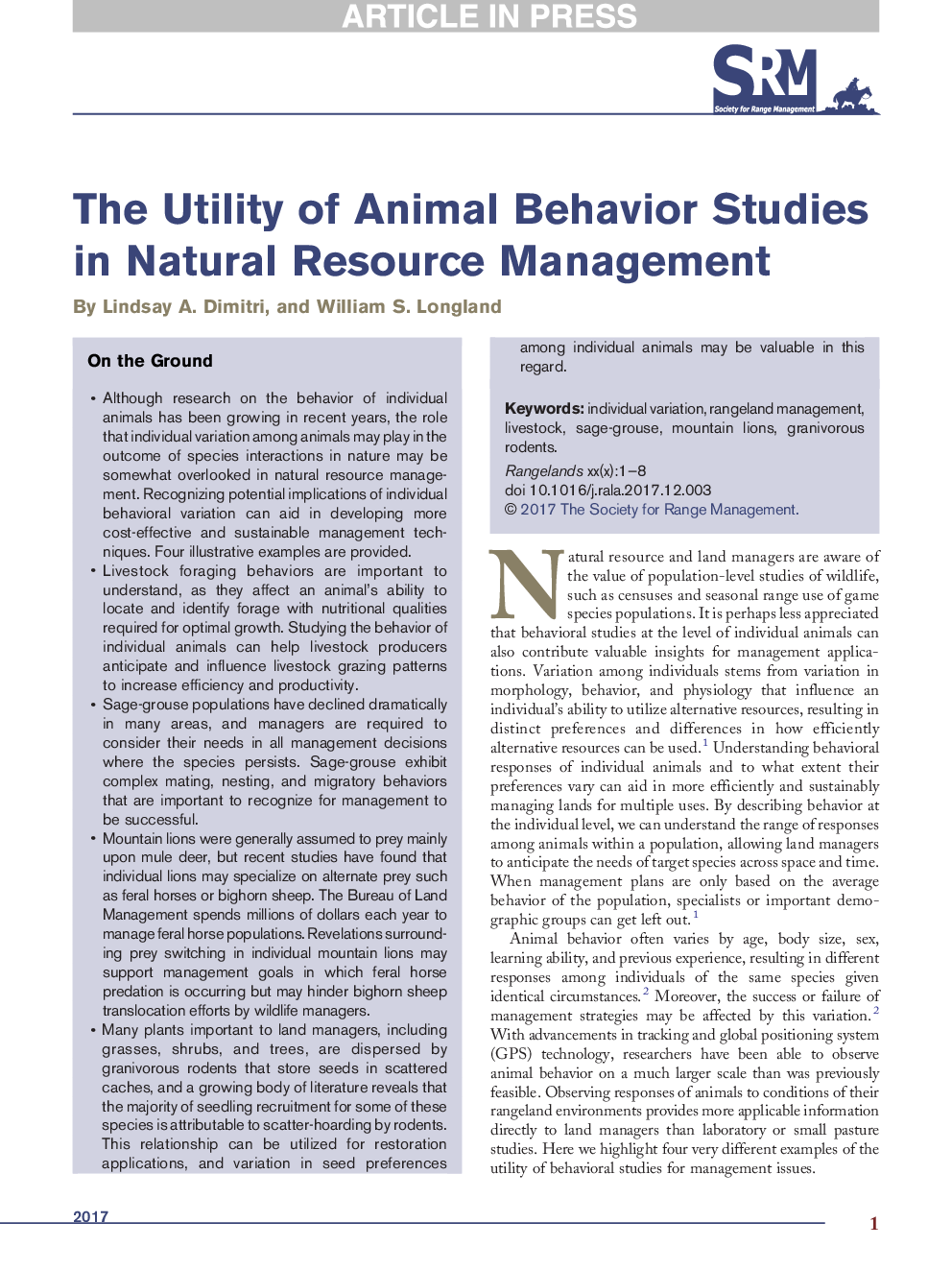| کد مقاله | کد نشریه | سال انتشار | مقاله انگلیسی | نسخه تمام متن |
|---|---|---|---|---|
| 8849675 | 1618651 | 2018 | 8 صفحه PDF | دانلود رایگان |
عنوان انگلیسی مقاله ISI
The Utility of Animal Behavior Studies in Natural Resource Management
ترجمه فارسی عنوان
سودمند بودن مطالعات رفتار حیوانی در مدیریت منابع طبیعی
دانلود مقاله + سفارش ترجمه
دانلود مقاله ISI انگلیسی
رایگان برای ایرانیان
کلمات کلیدی
تنوع فردی، مدیریت مرتع، دام مرغ دریایی، شیرهای کوهستانی جوندگان دانه گربه،
موضوعات مرتبط
علوم زیستی و بیوفناوری
علوم کشاورزی و بیولوژیک
علوم کشاورزی و بیولوژیک (عمومی)
چکیده انگلیسی
On the Ground
- Although research on the behavior of individual animals has been growing in recent years, the role that individual variation among animals may play in the outcome of species interactions in nature may be somewhat overlooked in natural resource management. Recognizing potential implications of individual behavioral variation can aid in developing more cost-effective and sustainable management techniques. Four illustrative examples are provided.
- Livestock foraging behaviors are important to understand, as they affect an animal''s ability to locate and identify forage with nutritional qualities required for optimal growth. Studying the behavior of individual animals can help livestock producers anticipate and influence livestock grazing patterns to increase efficiency and productivity.
- Sage-grouse populations have declined dramatically in many areas, and managers are required to consider their needs in all management decisions where the species persists. Sage-grouse exhibit complex mating, nesting, and migratory behaviors that are important to recognize for management to be successful.
- Mountain lions were generally assumed to prey mainly upon mule deer, but recent studies have found that individual lions may specialize on alternate prey such as feral horses or bighorn sheep. The Bureau of Land Management spends millions of dollars each year to manage feral horse populations. Revelations surrounding prey switching in individual mountain lions may support management goals in which feral horse predation is occurring but may hinder bighorn sheep translocation efforts by wildlife managers.
- Many plants important to land managers, including grasses, shrubs, and trees, are dispersed by granivorous rodents that store seeds in scattered caches, and a growing body of literature reveals that the majority of seedling recruitment for some of these species is attributable to scatter-hoarding by rodents. This relationship can be utilized for restoration applications, and variation in seed preferences among individual animals may be valuable in this regard.
- Although research on the behavior of individual animals has been growing in recent years, the role that individual variation among animals may play in the outcome of species interactions in nature may be somewhat overlooked in natural resource management. Recognizing potential implications of individual behavioral variation can aid in developing more cost-effective and sustainable management techniques. Four illustrative examples are provided.
- Livestock foraging behaviors are important to understand, as they affect an animal''s ability to locate and identify forage with nutritional qualities required for optimal growth. Studying the behavior of individual animals can help livestock producers anticipate and influence livestock grazing patterns to increase efficiency and productivity.
- Sage-grouse populations have declined dramatically in many areas, and managers are required to consider their needs in all management decisions where the species persists. Sage-grouse exhibit complex mating, nesting, and migratory behaviors that are important to recognize for management to be successful.
- Mountain lions were generally assumed to prey mainly upon mule deer, but recent studies have found that individual lions may specialize on alternate prey such as feral horses or bighorn sheep. The Bureau of Land Management spends millions of dollars each year to manage feral horse populations. Revelations surrounding prey switching in individual mountain lions may support management goals in which feral horse predation is occurring but may hinder bighorn sheep translocation efforts by wildlife managers.
- Many plants important to land managers, including grasses, shrubs, and trees, are dispersed by granivorous rodents that store seeds in scattered caches, and a growing body of literature reveals that the majority of seedling recruitment for some of these species is attributable to scatter-hoarding by rodents. This relationship can be utilized for restoration applications, and variation in seed preferences among individual animals may be valuable in this regard.
ناشر
Database: Elsevier - ScienceDirect (ساینس دایرکت)
Journal: Rangelands - Volume 40, Issue 1, February 2018, Pages 9-16
Journal: Rangelands - Volume 40, Issue 1, February 2018, Pages 9-16
نویسندگان
Lindsay A. Dimitri, William S. Longland,
